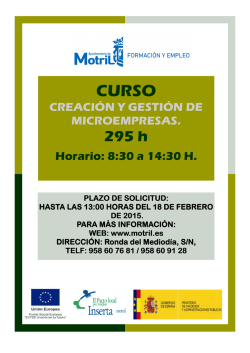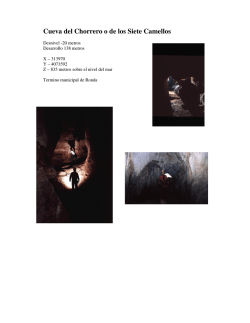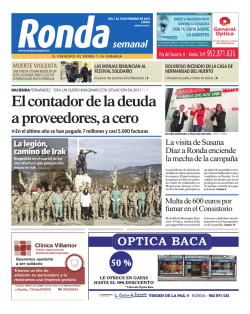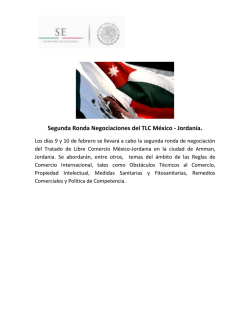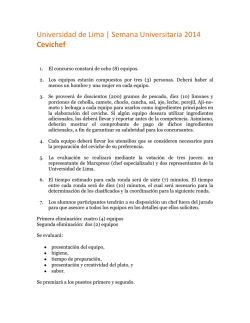
Folleto Vive la Historia. Parador de Ronda
Vive la Historia Live the History PARADOR DE RONDA Casi suspendido sobre el Tajo de Ronda, a casi doscientos metros de altura y no apto para los que sufren de vértigo, la grandiosidad del escenario que ofrece es uno de los atractivos del parador de Ronda. Muy próximo también a la célebre plaza de toros, reúne todos los atractivos que identifican a la ciudad. Almost suspended over the Tagus at Ronda, almost two hundred metres high and not suitable for those who suffer from vertigo, the grandiosity of the scenario it offers is one of the attractions of the Parador of Ronda. It is also very near to the famous bullring and brings together all the attractions which identify the city. El parador, inaugurado en 1994, se encuentra en el antiguo edificio del ayuntamiento y del mercado de abastos, junto al puente nuevo que separa los sectores nuevo y viejo de la ciudad. Aunque es un edificio de nueva planta, mantiene su fachada original a la plaza de España con sus arcadas, cornisas y primitivo reloj. De él destacan su ubicación, a medio camino entre el Tajo de Ronda y la plaza de toros, así como las infinitas y hondas panorámicas desde su terraza. The Parador was inaugurated in 1994 and is located in the former Town Hall building and the market, beside the new bridge which separates the new and old sectors of the city. Although it is a building with a new layout, it maintains its original façade giving onto the Plaza de España with its arcades, cornices and primitive clock. Its location is outstanding, half-way between the Tagus at Ronda and the bullring, as well as the infinite, deep panoramas from its terrace. EL ROMANTICISMO DESCUBRE RONDA Meca de escritores y artistas, el viaje español se convirtió en una de las grandes experiencias del romanticismo europeo. Atraídos por un país que, a sus ojos, aún mantenía su esencia y su color local, los románticos se enamoraron, sobre todo, de Andalucía por su pasado oriental, sus bandoleros y toreros, su ambiente meridional y su exotismo. Ronda reunía todos los ingredientes del mito romántico: una de las plazas de toros más antiguas de España, los relatos legendarios de la guerra de la Independencia y la belleza casi escenográfica de su serranía. ROMANTICISM DISCOVERS RONDA The Mecca of writers and artists, the Spanish journey became one of the great experiences of European Romanticism. Attracted by a country which, in their eyes, still maintained its essence and local colour, the Romantics fell in love, especially, with Andalusia due to its oriental past, its bandoleros and bullfighters, its southern atmosphere and its exoticism. Ronda brought together all the ingredients of the Romantic myth: one of the oldest bullrings in Spain, the legendary stories of the War of Independence and the almost scenography beauty of its hill country. LA COLECCIÓN TAURINA LUDWIG VON LANGENMANTEL, Andaluza, (1854-1922) Ronda es cuna de la tauromaquia española y una de las plazas más antiguas y bellas de España. En clara alusión a su tradición, el parador exhibe una colección de arte taurino que va desde el Romanticismo hasta la actualidad lo que indica la importancia del género y su vigencia en la cultura española. De un estilo clásico destacan, sobre todo, los retratos de Eugenio Lucas Villaamil y Ludwig Von Langenmantel, artistas coetáneos de finales del XIX, mientras que la visión contemporánea está representada por autores como Javier Clavo (el más representado de la colección) Francisco Farreras, Redondela o Cárdenas. Más allá del costumbrismo, los cuadros muestran la amplitud del toreo y sus conexiones con el Romanticismo y la cultura goyesca en los retratos clásicos, pero también cómo ha interpretado la pintura española actual este género llevando el expresionismo, la abstracción geométrica, la violencia cromática o la esquematización a la representación del toro y la tauromaquia. Aunque la colección es mayoritariamente pictórica también destaca una escultura en bronce de pequeño formato del escultor murciano José Carrilero. THE BULLFIGHTING COLLECTION TAMBIÉN LE GUSTARÁ: YOU WILL ALSO LIKE THE FOLLOWING: Plaza de toros de Ronda y Museo de la Real Maestranza de la Caballería. The Bullring of Ronda and the Museum of the Real Maestranza de la Caballería Paseo por la Alameda del Tajo y los puentes.Walking along the Poplar Grove of the Tagus and the bridges Paseo a pie por la ciudad de Ronda. Walking through Ronda Ronda is the cradle of Spanish bullfighting and has one of the oldest and most beautiful bullrings in Spain. In clear allusion to its tradition, the Parador exhibits a collection of bullfighting art which goes from Romanticism to the present time, which indicates the importance of the genre and its continuity in Spanish culture. Outstanding in the classical style are the portraits of Eugenio Lucas Villaamil and Ludwig Von Langenmantel, contemporary artists of the end of the XIX century while the contemporary view is represented by artists such as Javier Clavo (the most represented in the collection), Francisco Farreras, Redondela and Cárdenas. Beyond costumbrismo (style dealing with national or regional social customs), the collection shows the broadness of bullfighting and its connections with Romanticism and Goya culture in the classical portraits, but also how current Spanish painting has interpreted this genre, applying expressionism, geometrical abstraction, chromatic violence and schematization to the representation of the bull and bullfighting. Although the collection is mainly pictorial, there is also an outstanding, small, bronze sculpture of the sculptor from Murcia, José Carrilero.
© Copyright 2026
